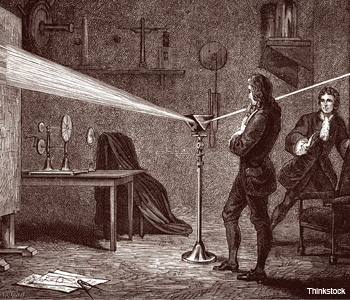Feature
A History of Human Color Vision—from Newton to Maxwell
Color vision has attracted the attention of philosophers and scientists throughout the ages—from Aristotle to Goethe to Schrödinger. This article tracks the history of color vision over more than three centuries, with a particular emphasis on the contributions of James Clerk Maxwell.
 Isaac Newton's prism experiment.
Isaac Newton's prism experiment.
In the early 18th century, Isaac Newton laid the groundwork for our understanding of color with his classic Opticks (1704). In that volume, Newton described his experiments on the role of a prism in the decomposition of sunlight into its component colors, which could be recombined to form white light. Newton named, but did not observe, a total of seven spectral colors—red, orange, yellow, green, blue, indigo and violet.
…Log in or become a member to view the full text of this article.
This article may be available for purchase via the search at Optica Publishing Group.
Optica Members get the full text of Optics & Photonics News, plus a variety of other member benefits.
